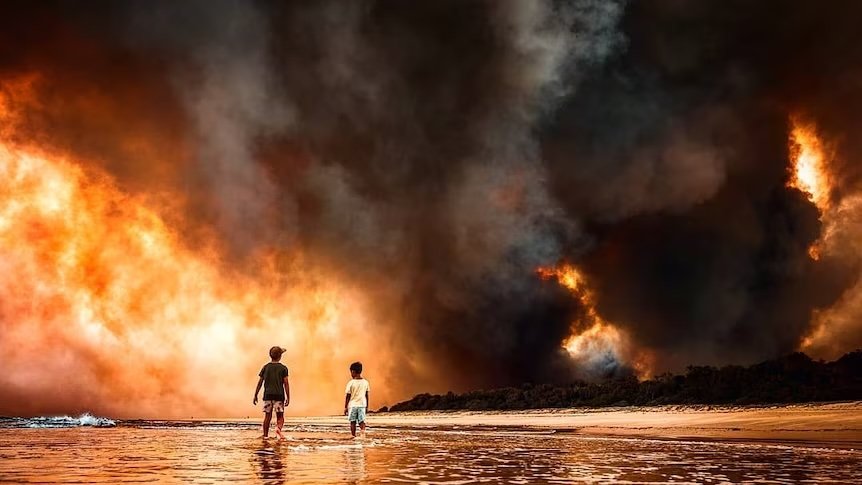Understanding the social impacts of climate change
And why people—not just infrastructure—need to be at the centre of how we adapt
When we talk about climate change, we often stop at the obvious layer. Fires. Floods. Heatwaves. Rising seas.
These impacts are real, and growing, and visible. But there’s another side to the story—less talked about, but no less urgent.
It’s what happens when a renter in Western Sydney can’t cool their home. When families have to leave Canberra and retreat to friends in Sydney due to heavy smoke. When families are displaced—again—and the fragile systems around them start to unravel.
These are the social impacts of climate change. And they’re already here, shaping daily life, deepening inequities, and determining who adapts—and who’s left behind.
Why the social lens matters
Climate change doesn’t impact everyone equally. And it doesn’t just damage the environment—it magnifies the vulnerabilities already present in our systems.
When housing, health care, energy, and community services are already under strain, climate becomes a multiplier, pushing people closer to the edge.
And so, planning with a social lens is crucial. Because when we leave the social dimension out of climate resilience, recovery gets slower, more expensive—and less fair.
What the data says
Source: ABC website
Housing and shelter insecurity
1 in 25 homes in Australia could be uninsurable by 2030 due to a lack of climate readiness. In some places like Shepparton, it could be nearly 9 in 10 homes (The Guardian, 2025).
Renters face higher exposure to heat and poor-quality housing but have less control over adaptation.
Rising insurance premiums and unaffordable rebuild costs deepen housing insecurity post-disaster.
Health and mental wellbeing
Heatwaves are Australia's deadliest natural hazard, especially for older adults and those with chronic illness.
Psychological impacts are also rising—94% of psychologists report concern about climate-related mental health impacts (APS, 2024)
Projections from the University of Adelaide suggest a 50% increase in climate-driven mental and behavioural disorders by 2050 (University of Adelaide, 2025).
Financial and food stress
Energy and grocery costs are rising as climate events strain supply chains and grid reliability (The Australia Institute, 2025).
Households in heat-stressed suburbs face skyrocketing bills but limited ability to cool homes or relocate.
Casual workers often lose income during disasters, without safety nets.
Community disruption and loss of place
84% of Australians have been directly affected by a climate disaster since 2019 (Climate Council, 2024)
Displacement after fires or floods fractures communities, disrupts informal care networks, and accelerates social isolation.
Cultural sites and local gathering places are often lost without recovery plans.
Education and work disruption
School closures due to bushfires, smoke, floods, or extreme heat have affected student learning and parent workforce participation.
Remote and regional students face disrupted access to consistent education, exacerbating educational inequality.
Employment is increasingly disrupted in climate-exposed sectors like agriculture, tourism, and outdoor trades.
Widening inequality
Climate change exacerbates existing disadvantage—impacting First Nations peoples, women, migrants, and people with disability most.
Many recovery programs prioritise homeowners, leaving renters and undocumented residents behind.
Public policy responses still often ignore compounding vulnerabilities.
Breakdown of care and informal support systems
Carers face increased load during disruptions—especially women, grandparents, and informal support networks.
Volunteer networks are stretched thin as communities face back-to-back climate disruptions with little recovery time.
Ageing populations and people with disability are left more isolated when support systems falter.
Eroding trust in systems
When disaster responses are slow, inequitable, or poorly communicated, trust in institutions erodes.
Perceptions of "climate winners and losers" rise if resources are distributed inequitably or if lived experience is ignored.
Planning decisions that overlook community voice risk disengagement and opposition.
These risks are not in the future. They are already here.
They’re playing out now—in suburbs, towns, and households across Australia. And they’re exposing the limits of systems we once assumed would hold.
But here’s what gives me hope: none of this is inevitable.
We already know what works—when equity, foresight, and community voice are built into decision-making from the start.
We can plan for social resilience. We can design for people, not just risk. But we have to name the social risks clearly—and treat them as core, not peripheral.
What needs to shift
Addressing the social impacts of climate change isn’t about patching up the fallout. It’s about embedding resilience into how we design communities, services, infrastructure, and support systems.
To build social resilience we can:
Treat social infrastructure (like schools, libraries, and community hubs) as core climate infrastructure
Embed equity into every stage of planning
Design systems that adapt, flex, and respond to lived experience
And listen—really listen—to those already on the frontlines.
Because resilient places need resilient people. And resilient people need support, voice, connection, and care.
If we want resilient places, we need resilient people—and, as always, this means keeping people front and centre of the work that we do.
Want to find out more? Or can we help shape your next project? Reach out to Liesl Codrington, Director Vaere Social, for a chat (liesl@vaeresocial.au).


